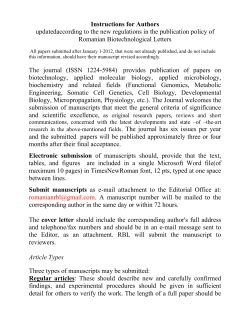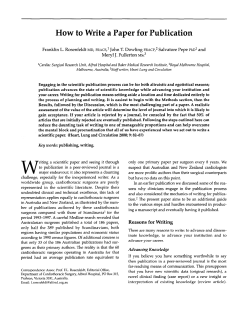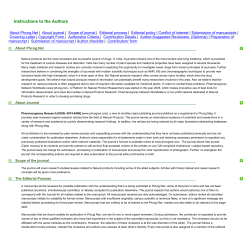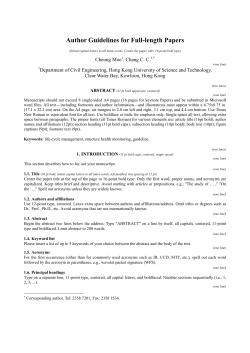
It’s Not Personal! Pointers for Responding to Reviewers
It’s Not Personal! Pointers for Responding to Reviewers The third in a series of articles providing guidance to researchers on the publishing process for peer-reviewed scientific journals Peter E. Jensen, Professor and Chair, Department of Pathology, University of Utah This article is one in a series based upon presentations made during an IMMUNOLOGY 2011™ AAI Publications Committee Symposium titled In the Lion’s Den: The Manuscript Review Process and How to Survive It. Jensen is currently a deputy editor for The Journal of Immunology. As scientists, we communicate our findings and discoveries primarily through the publication of peerreviewed manuscripts. The peerreview process helps to validate our results and conclusions, a first step in the process through which our studies influence the broader scientific thinking. We all invest a tremendous amount of work and expense in generating Peterr Jensen the data for each manuscript. And we put significant effort into writing and preparing each manuscript for submission. Our publications are critical to our prospects for obtaining jobs, keeping them, earning promotions, and gaining funding. Findings that are not published or read have no impact. Given the importance to our careers of our every submission, I’ll offer here some of my own personal views on how to approach the manuscript review process and respond to the critique in the most constructive way. That is to say, in such a way that you can enhance your chances for successful publication. My comments are tailored for The Journal of Immunology (The JI), but the principles can be applied generally to any peer-reviewed journal. The Editor’s Letter Journals generally use standard wording to communicate the initial editorial decision. The typical range of decisions includes the terms “accept,” “minor revision,” “major revision,” and “reject.” I’ll briefly re-trace the path of a manuscript en route to a decision, as was discussed earlier in this series in “I Just Clicked Submit. What Happens Next?” by Juan Carlos Zúñiga-Pflücker (AAI Newsletter, October/ November 2011, pages 28–30). I’ll attempt also to describe what I believe to be constructive responses to each decision you may receive. A decision by a journal to accept an initial submission is wonderful but rare. Upon acceptance, you simply follow the instructions for reviewing galley proofs, paying page charges, consenting to copyright transfers, and other steps in the production process. Be prompt and thorough in each www.aai.org step taken. You don’t want to tempt fate by causing delays in the process. An outright rejection generally indicates that your paper will never be acceptable for publication in this particular journal. You should consider using the accompanying critique to help guide a major revision for submission to another journal. The study may be considered too preliminary, poorly performed, poorly presented, or it may need too many experiments to complete a convincing story. The reviewer may question whether his/her journal was the appropriate one for the study. For instance, a reviewer for The JI may ask whether the work is really a study in immunology. Keep in mind, also, that reviewers and/or editors may reject a study they consider insufficiently novel, significant, or interesting. For example, a study might demonstrate for the first time the role of specific cytokines or transcription factors in a particular animal model of organ-specific inflammatory disease. However, the findings might be considered to be entirely predictable based on previous studies with other models of inflammatory disease. No doubt, you’ll entertain the impulse to rebut the reviewer’s decision to reject your manuscript, and you’ll want to send a letter to the editor-in-chief requesting reconsideration. You should, however, consider sending such a rebuttal letter only if you believe that a serious scientific error has occurred during the review process. If important new data have been obtained since the original submission and decision, they may be incorporated into the rebuttal with the implication that the new data will address the major criticism. Note, though, that if the new data change the manuscript substantially, it is generally best to submit a new manuscript. The overall success rate for rebuttals is very low. Success is more likely for someone receiving a journal editor’s letter indicating a “minor-revision” decision. Such a letter generally includes a statement such as “The manuscript is acceptable for publication in The Journal of Immunology contingent upon revision.” This Continued on next page AAI Newsletter 17 response often means that little or no additional experimental data will be required, and if additional data are required, the reviewer anticipates the data will be relatively easy to obtain. This decision is good news, but the authors still must address each point in the critique and make expected modifications to the manuscript. Note that no guarantee has been made that the paper will be accepted for publication. Formulating a Plan By contrast, a “major-revision” decision by a journal probably includes wording such as “Although the subject matter of your paper is of interest, a number of concerns were raised by the reviewers. While these concerns preclude publication of this manuscript in its current form, you are invited to resubmit an appropriately revised manuscript that addresses the reviewers’ concerns.” A successful revision in this situation will generally require important additional data and significant revisions to the manuscript. The Critique The JI asks its reviewers and section editors to evaluate manuscripts on the basis of originality, scope, clarity, and significance of the manuscript. Weakness in any one of these areas can lead to a rejection. Other factors commonly leading to a decision to reject include reviewers’ assessment that the work is too descriptive or that it lacks any statement of a clear hypothesis, mechanistic insight, or precise implications of the study for the field of immunology. Novelty may be an issue. The paper may have been given a low score for a lack of originality or unique significance. If so, you may receive comments such as “This work has been done before,” or “Just another cell type,” or “Two recent studies support very similar conclusions.” These comments provide a very clear indication of why the paper was rejected. If you are offered a chance for revision, you will need to add novel data or make a convincing case for the originality and significance of your results. The reviewers may conclude that the work is premature for publication. The experimental design or analysis may be considered faulty. Critical results may be viewed as being weak or unconvincing. Data may be poorly presented, unclear, labeled incorrectly, or lacking statistical analysis. (For excellent guidance on the presentation of data, see “Making It Easier for the Reviewer,” by Melissa Brown, AAI Newsletter, December 2011, pages 27–30.) If you are invited to revise and resubmit your manuscript, be sure to take the time to carefully evaluate the reviews and formulate an action plan. As a first step, carefully read the critique. Then put it aside and wait a few days before reading it again. Doing so gives you time to let your initial emotions subside and approach the critique objectively. Next, make a list of the specific points made by each reviewer. Remember, it is not helpful to assume that a negative critique is the consequence of bias or any lack of expertise on the part of the reviewer. If the reviewer has misunderstood your results or line of reasoning, focus on ways to improve the clarity of your presentation in the manuscript rather than the competency of the reviewer. Next, outline the issues. If you get the impression that the novelty or significance is in question, draft a point-bypoint response to the critique to indicate what additional experiments are feasible and which are not. Identify what points can be addressed by argument alone as you edit the manuscript or add additional references. Consider whether you are being told that there are flaws in your logic or design and/or your controls are inappropriate and unconvincing. Are there concerns cited relating to over-interpretation or reagent validation or are divergent points of view expressed in your paper? Ask colleagues and co-authors to read the reviews and weigh in with their opinions. Decide whether you can resubmit and what would be needed to have a reasonable chance of success. In some situations, you may decide that it is not practical to try to satisfy major concerns raised in the critique. You may conclude that you would be better off repackaging the paper for another journal. If, however, you decide to re-submit, you will need to formulate a plan to perform any required additional experiments, obtain additional information requested by the reviewers, and revise the manuscript appropriately. If clarity of your writing or language is an issue, get help from colleagues or even engage a professional copy editor. Our publications are critical to our prospects for obtaining jobs, keeping them, earning promotions, and gaining funding. Findings that are not published or read have no impact. Even if reviewers consider the topic to hold potential for adding significantly to the body of knowledge in the field, any weaknesses they’ve identified in the data or conclusions must be satisfactorily addressed before they can recommend publication. 18 AAI Newsletter January/February 2012 If the reviews are highly divergent, don’t assume that the favorable review will be weighed more heavily than the unfavorable one. You may conclude that a reviewer is uninformed or has negative biases, but you should still take the review seriously. Even a relatively positive review may not be as positive as it seems. Reviewers often provide confidential comments to the editors that are less “gentle” than their comments to the authors. In addition, the narrative reviews do not always reflect the ranking scores provided by the reviewers. That said, know that you can respond only to the comments that you have received. A good-faith effort to respond objectively to each point raised in the critique greatly boosts one’s chances for acceptance of a revised manuscript. Emotions and Professionalism It’s only natural to react emotionally to criticism. Be advised, though, not to let your emotions show as you begin to write the point-by-point response and cover letter that will accompany your resubmission! Reviewers have emotions, too, and they are also subject to the temptation to react poorly to comments questioning their expertise, intentions, or objectivity. You will not win favor if you state that “Reviewer #1 obviously has little expertise in the field,” or “This reviewer clearly delegated the task to a first-year graduate student.” Even a less “snarky” response can seem arrogant if not carefully phrased. Avoid such dismissive remarks as “The reviewer appears not to have read the manuscript, as these points were clearly addressed in the original paper,” or “We were surprised that the reviewer had such a difficult time understanding this point.” You will benefit from a professional and respectful tone. A politic response might read, “We thank the reviewer for her constructive comment. We have clarified our reasoning in the revised manuscript with changes in the Results section on p. 14,” or “The reviewer’s concerns are understandable. We provide additional data in Fig. 5 of the revised manuscript that strengthen this conclusion.” There’s merit in the proverb “You catch more flies with honey than with vinegar!” validate reagents, add controls, and employ alternative approaches as necessary to strengthen the manuscript. If novelty is an issue, consolidate the original figures and provide new data. If your work contrasts with published studies, your data need to be particularly strong and convincing! Don’t risk seeming to “cherry pick” your revisions. Be sure to address all issues identified by the reviewers. Don’t ignore any comments raised in the reviews. Take great care in the creation of your figures. In your use of statistics, be sure to choose the right statistical tool. Immunologists vary considerably in their expertise with statistics. If you don’t know what approach to use, get help from someone with more expertise. You may also consult “The Appropriate Use of Statistics in the Biological Sciences,” by Pamela A. Shaw, in the AAI publication Scientific Publishing: Dos and Don’ts for Authors and Reviewers, available for downloading at www.aai.org/ About/Publications/Additional/Docs/AAI_Dos_Donts.pdf. Again, see “Making It Easier for the Reviewer,” by Melissa Brown, AAI Newsletter, December 2011, pages 27–30. In her article, she offers very specific guidelines for creating figures. Consider validating your results in vivo if feasible. In general, results with primary cells are better than results with transformed cell lines. The most convincing results often come from validation studies in animal models. For example, one might demonstrate that a specific signaling molecule is required for differentiation of a particular subset of T cells in tissue culture assays. The physiological role of this signaling molecule would be more firmly established by showing an effect of blocking the molecule during T cell differentiation induced in an in vivo model in animals. In vivo results can greatly increase the perceived biological significance of the findings. Finally, you should prepare a cover letter that includes your point-by-point response and a concise summary of the ways the revised manuscript has been strengthened. Again, ask a colleague to read your cover letter to help you confirm the thoroughness and clarity of your response. Resubmission In the End Once you have obtained the additional required data and information defined by your outline of the critique, you can finalize the point-by-point response and the manuscript revision. In composing the point-by-point response, separate out each point of each review in quotation marks and write the corresponding response below each point. Peer review is qualitative, imperfect, and, because we are human, sometimes biased. But it is the best system that we have! As painful as it can be, the process generally results in the publication of improved manuscripts. As an author responding to a review, remember that you are also occasionally a reviewer. When you review, remember that you are often the author. Civility and respect should prevail in each of your roles. Keep your responses brief and clear. Be sure to note where changes have been made in the manuscript. Don’t make the reviewer have to search for the changes. Address issues with additional data whenever possible. It is often easier to perform additional experiments than to waste time and effort on verbal arguments. Fix flaws in design, www.aai.org Be assured, all of us at some point have papers rejected. What’s most important is to move forward, stronger for having dealt constructively with the critiques we’ve received and confident that we are better prepared for our next submission. Take heart! AAI Newsletter 19
© Copyright 2025





















